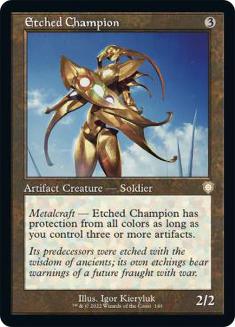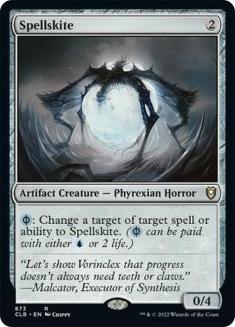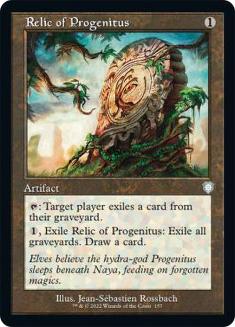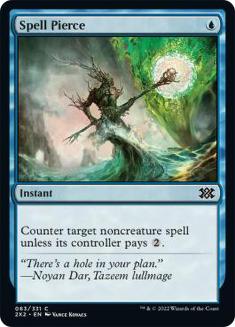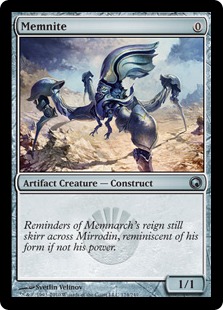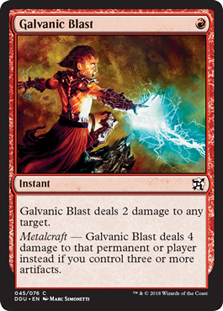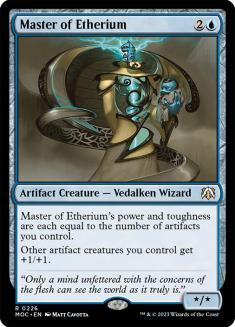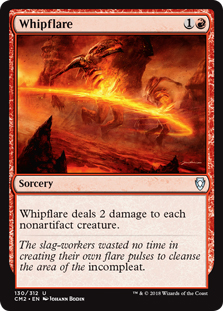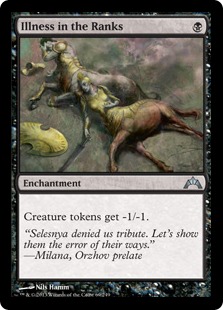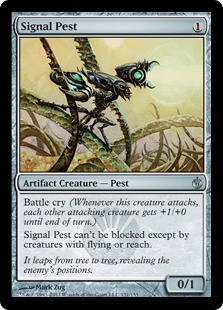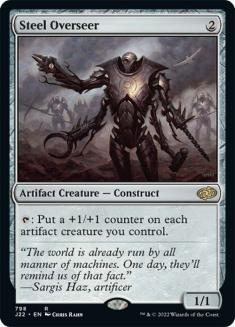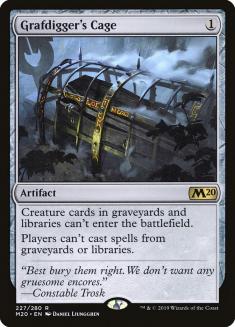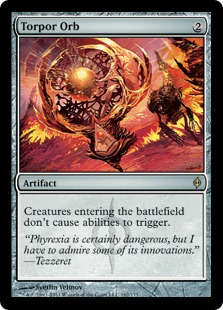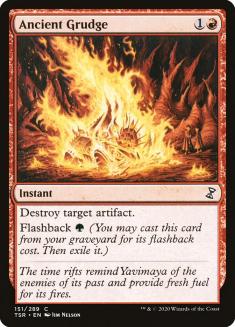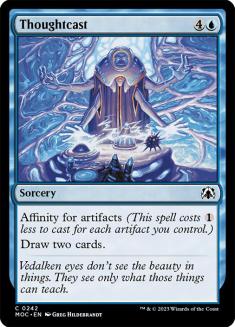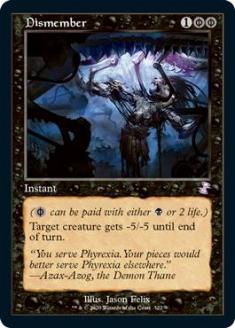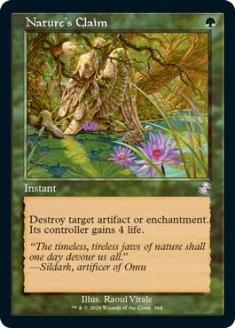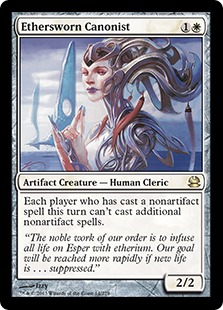Earlier this week I put together a comprehensive guide on how to build Affinity, when the right time is to play the deck, and some of the tips and tricks that people may not know about. You may have noticed that I left out a detailed matchup analysis. That was not on accident.
To give a better idea of how all of Affinity’s matchups tend to go as well as provide a bit of direction for how to sideboard in them, I have listed as many Modern decks as I could think of below. They are in no particular order, but attached to each matchup is a rough pre- and post-board game plan as well as some guidelines for how to change your deck to play against it.
Jund
This matchup is mostly about attrition. They have lots of removal, including Abrupt Decay for your Cranial Plating, so the best way to win is usually to swarm them. Get as much early damage in as you can before they start to remove your permanents and hopefully let Galvanic Blast / their own Dark Confidant deal the rest. Arcbound Ravager and Steel Overseer often immediately draw a removal spell, so you can use them as bait to set up a huge Cranial Plating hit. You’ll win a lot more game 1s if you’re starting Etched Champion. Thoughtseize is important after board to try to get rid of Shatterstorm as well as to have an idea of what removal spells to play around.
Good Cards
Bad Cards
Ajundi
I’m not sure if Ajundi is still around without Deathrite Shaman, but nevertheless it plays a bit differently. You have to worry about Lingering Souls and most likely Stony Silence out of the board, so your plan should be a little different. Whipflare and Illness in the Ranks are good to stop their tokens, and it’s worth bringing in one or two pieces of enchantment removal if you have it (since they don’t usually kill you very quickly).
Good Cards
Bad Cards
U/W/R Control
This matchup is hard. If they have an early Spell Snare followed by an Electrolyze and one other removal spell, it may not be possible to win. The best way to win is to try to sneak a Cranial Plating in through a counterspell. That way every single creature you play becomes a must-kill threat and it’s easier to run them out of gas. If they have Tectonic Edge, be careful not to play out a fourth land if you don’t need it.
After sideboard if they don’t immediately make things very difficult for you with Stony Silence, it’s all about assembling an Etched Champion with a Plating (or an Arcbound Ravager and a bunch of counters). It’s generally easier to resolve Champion than it is a two-mana spell due to Spell Snare. Make sure to try to defend your Champ from Supreme Verdict (if people still use that instead of Anger of the Gods) as well as your Platings from Wear // Tear with Welding Jar. If you have enchantment removal, it’s worth bringing it in to try to kill Stony Silence since the games tend to go long. I also usually like to bring in one Grafdigger’s Cage if I have it because it’s worth one card to me to stop Snapcaster Mage (and sometimes Think Twice).
Good Cards
Bad Cards
U/W/R Midrange
This matchup plays pretty similarly to U/W/R Control except it’s easier to resolve spells (fewer counters) and harder to attack (more flash creatures). For the most part the same principles apply; just be more careful about attacking into a potential Restoration Angel. Galvanic Blast is worth keeping around in this matchup. Depending on what creatures they have, Torpor Orb might be effective. Also, if they have Blade Splicer, it’s worth bringing in Ancient Grudge since otherwise the Golem will be able to block Etched Champion.
Good Cards
Bad Cards
Zoo
This matchup is relatively straightforward—there aren’t that many surprises they can have, but they come at you very quickly. Be careful about being tricked into a Lightning Bolt into Path to Exile sequence, and otherwise just try to assemble a fast clock in the air while managing the ground with Arcbound Ravager + creatures you don’t really care about. If you have time to get it down, Etched Champion is usually awesome. Be careful not to waste Galvanic Blast on creatures if you don’t have to since they tend to deal so much damage to themselves via fetch and shock lands that you can very easily just go upstairs and kill them.
After board they typically have Ancient Grudge and sometimes Stony Silence. A turn 2 Stony Silence with a fast clock is almost impossible to beat, especially since it’s not really worth bringing enchantment removal in because the matchup is so fast (well, Nature’s Claim maybe since it doubles as life gain). Spellskite is awesome since it blocks Zoo’s animals so well; makes it hard to Lightning Bolt anything; and eats a Path to Exile, one half of an Ancient Grudge, or a similar removal spell. Thoughtcast gets worse because it’s not always easy to find time to cast it.
Good Cards
Bad Cards
Splinter Twin
This matchup is not so easy game 1, but it’s very hard if you don’t have Galvanic Blast in your deck to stop the turn 4 combo kill. They go for it a large amount of the time, so if you don’t have it, don’t waste mana representing it if it will cut a turn off your clock. If you do have it, try to leave two colored mana up if you can since they will tap one on your end step with Deceiver Exarch or Pestermite and you want to get both the creature and the Twin if you can.
You will probably want to board in a lot of cards for this matchup. Illness in the Ranks is awesome since it stops the combo and is hard to remove (they usually only have Engineered Explosives or a bounce spell). Spellskite and Torpor Orb are great, especially with Welding Jar to defend them. Be careful about exposing too many two-cost cards to Engineered Explosives. Dismember is fantastic since you don’t have to worry about them tapping your only colored source. If your specific sideboard is lacking cards for this matchup, it’s not unreasonable to bring in enchantment removal as extra anti-combo protection. If it’s the U/W/R version, you almost certainly want it since it doubles as an answer to Stony Silence.
There are so many versions of this deck that it’s hard to have one game plan that works for all of them, so you’ll have to rely on your intuition a little bit to know which card choices matter the most. For example, I like having two Etched Champion versus the all-in combo version but not four since they want to try to win early and your hand could get clogged with too many three-drops. However, against the RUG and U/W/R versions, I like having all four since they have lots of other stuff to do besides combo and the games tend to go a bit longer.
Good Cards
Bad Cards
Burn
This matchup is a bit more than just a race. Getting a Vault Skirge into play and defending it is the best way to lock the game up (try not to pay two life for it if you can help it). Other than that the best way to win is to convince the opponent that they need to use their burn spells on your creatures and not you by developing a menacing board as quickly as you can. If you can make a seven-toughness Vault Skirge via Arcbound Ravager while they are tapped out, it will be hard for them to stop it since they will need three burn spells (and not all of their spells hit creatures). Use Galvanic Blast to "gain life" by killing anything that’s attacking you (yes, even Hellspark Elemental). If it’s Goblin Guide, be sure to get the trigger first.
If you have Duress over Thoughtseize, lucky you since Duress is awesome in this matchup and Thoughtseize isn’t. Otherwise, you’ll probably just want Etched Champion and Spellskite. Also, sometimes they have Ensnaring Bridge, so if you see it in game 2 or know they have it, feel free to bring Ancient Grudge in. Nature’s Claim is also awesome since it’s primarily a life gain spell in this matchup. If they have Bridge and you don’t have a way to kill it, you can still beat it by attacking with zero-power creatures (Ornithopter and Signal Pest) and attaching Cranial Plating to them at instant speed or making them lethal with Arcbound Ravager after they’ve already attacked.
Galvanic Blast is a bit more relevant after board since some lists are starting to use Satyr Firedancer. Don’t forget to sacrifice whatever they target with Smash to Smithereens to Arcbound Ravager (including the Ravager itself) to counter the spell and avoid taking three damage. Smash to Smithereens is the most common hate card followed by Shattering Spree and then Rakdos Charm.
Good Cards
Bad Cards
Melira Pod
Similar to Splinter Twin, this matchup is hard to win in game 1 if you don’t have Galvanic Blast since their plan A is to combo you. Remember that Inkmoth Nexus does not interact favorably with Melira, Sylvok Outcast. Watch out for nasty singletons that can come out at instant speed via Chord of Calling (the scariest one is probably Orzhov Pontiff). If they’re using Birthing Pod or Chord of Calling to get a four-mana creature, it might be Linvala, Keeper of Silence, so try to get your activations in before it has a chance to come into play.
After board you should have a bit more removal as well as some hate cards like Torpor Orb or Grafdigger’s Cage. It might be falling out of favor, but a big part of their post-board strategy at one point was Lingering Souls, in which case it’s worth it to bring in Illness in the Ranks to stop it. Whipflare is always good if you have it.
The other big plan they have after board is to get Kataki, War’s Wage in play, so be very careful about tapping out or overcommitting. It’s good practice to always have mana for a removal spell up anyway, but it goes extra if you risk losing a huge chunk of your board to Kataki. I’ve seen some Affinity decks play Gut Shot in the sideboard before, and I assume this is mostly what it’s for. I think that idea is kinda neat if you have space in your board and expect to play against a fair amount of Pod decks.
I think graveyard hate (aside from Cage, which doubles as library search hate) is not very good in this matchup, so I wouldn’t bring in Rest in Peace or Relic of Progenitus—their plan B is so strong that these cards will usually just be a minor annoyance. I also don’t bother to bring in Ancient Grudge (if they have the opportunity to activate a Birthing Pod multiple times without fear of dying to your board, you don’t have a great chance of winning that game anyway). I do however like Thoughtseize quite a bit, so bring those in if you have them.
Good Cards
Bad Cards
Kiki Pod
A lot of the principles in the Melira Pod matchup apply to this one as well—keep removal up in case they to combo, etc. However, this matchup has a few different things to watch out for, most notably Restoration Angel and Izzet Staticaster. Be mindful of both of those cards by not attacking into lots of open mana or deploying multiple copies of one-toughness creatures if you can avoid it.
The post-board strategy is almost identical to Melira Pod—removal is good, Torpor Orb and Cage are good; killing Birthing Pod is bad; watch out for Kataki, War’s Wage. At least in this matchup, you aren’t even tempted to bring in other graveyard hate since they hardly use the graveyard at all. The one main difference is that Whipflare is not very good at all against this deck, so I wouldn’t bring it in if I had it.
Good Cards
Bad Cards
Merfolk
This matchup is often simply a race to see who can assemble more synergy faster. Fortunately, their only flying creature (Coralhelm Commander) needs to be leveled before it actually has flying. Vapor Snag is often their only interactive card in game 1, so watch out for it. Try not to tap out for Galvanic Blast or Thoughtcast if they have an Aether Vial on one since they could Vial in a Cursecatcher and counter it. Remember that Mutavault can block Etched Champion (which is otherwise your best way to win), so if they have an untapped one with open mana, be careful about attacking into it.
Unless you need the mana, you can counter Spreading Seas on your creature lands by activating them in response and then sacrificing them to Arcbound Ravager. If a Darksteel Citadel somehow ends up with a Spreading Seas on it, remember that it still has the card type Artifact, so you can sacrifice it to Ravager and block creatures with Islandwalk (as long as you don’t have another Island in play of course). If you have a basic island in your deck, try not to play it unless you really need to.
Dismember is really good after board since you are still probably saving life by killing a Merfolk lord even if you pay four life to cast it. Thoughtseize is also unusually good (it’s generally not great in aggro matchups like this) since you can take reactive cards like Vapor Snag and Hurkyl’s Recall before they get a chance to play them as well as just see what they’re up to.
Good Cards
Bad Cards
Soul Sisters
I’m lumping all versions of this archetype together since they play very similarly. I like these matchups in general, but they have lots of annoying cards that make it hard for you to win, so some of their draws just aren’t beatable. Soul Sisters can gain a bunch of life but has a hard time actually killing you, so the best way to win is to eventually find an Etched Champion (if you play one maindeck) and win with a few huge Cranial Plating hits.
After that the next best way is poison counters via Inkmoth Nexus, but it can be hard to attack past Spectral Procession tokens if you don’t have an active Steel Overseer going. Galvanic Blast is best used on Ajani’s Pridemate or Serra Ascendant (before they get to 30 life); otherwise, you will need Etched Champion on the ground to defend or an Arcbound Ravager to block with a flying creature and sacrifice to counter the lifelink.
The Norin the Wary version is more aggressive with Purphoros, God of the Forge and more removal, but it also lacks flying creatures, so it’s easier to win with Inkmoth Nexus as long as the coast is clear from removal.
Torpor Orb is excellent after board since these decks rely on enters the battlefield triggers quite a bit. Whipflare is also very good for obvious reasons. Enchantment removal is great too since they often have Stony Silence but can use some other enchantments like Honor of the Pure or Suppression Field. Etched Champion should be your plan A after sideboard. Galvanic Blast is actually kinda lackluster after board, so feel free to shave some if you don’t know what else to bring out.
Good Cards
Bad Cards
G/R Tron
This matchup is all about the creature lands: Inkmoth Nexus and Blinkmoth Nexus. They are the only creatures that can survive an Oblivion Stone activation, and Inkmoth can still kill your opponent no matter how much life is gained via Wurmcoil Engine. Most Tron decks have two copies of Ghost Quarter maindeck, so be really careful about putting a bunch of Arcbound Ravager counters on a Nexus if it’s not lethal (unless you have Welding Jar).
Always try to leave one mana open if you have Ravager and Nexus since you need to be able to activate a Nexus to get the modular trigger if your opponent plays and activates Oblivion Stone in the same turn. Be careful about playing into Pyroclasm in the early turns, and remember to prevent the life gain from Wurmcoil Engine by blocking with creatures and then sacrificing them to Ravager.
Etched Champion is by far the worst card in this matchup since it’s just a 2/2 for three with virtually no text. Thoughtseize and Spell Pierce are as good as expected (although Pierce gets way worse if the game goes long), but Spellskite is actually deceptively strong. Not only can it redirect Nature’s Claim and Karn activations, but it also redirects fate counters from Oblivion Stone if the need to do that ever comes up. Thoughtcast is underwhelming since the games don’t typically go very long. Galvanic Blast is also underwhelming, but it’s a bit more useful than Thoughtcast since you can use it to take out a Karn that’s been activated once or if all else fails go straight to the dome.
I usually bring in Ancient Grudge if I have it since it’s useful to take out (most of a) Wurmcoil Engine or if you catch them casting an Oblivion Stone without the mana to activate it in the same turn (which they shouldn’t be doing). Also, you can destroy it in response if they ever try to add a fate counter to something (which is a more likely scenario)
Good Cards
Bad Cards
Scapeshift
This matchup plays like control until they have what they need to kill you, so you should play just like you would against a normal control deck—don’t play into obvious counters and removal and just try to kill them as fast as possible. If they are playing a version with Cryptic Command, try not to move in on a two-turn Nexus clock since it can be backbreaking to both lose a bunch of Arcbound Ravager counters and a land drop. The biggest advantage you have in this matchup is that you don’t take any damage from your lands, so they almost always need eight lands in play to kill you (the exception being if you paid two life to cast a Vault Skirge and it died before you could gain any life back).
Unfortunately, sideboard options for this deck are few and far between—the good ones that do exist are so narrow that it’s not worth including them just for this matchup unless you expect it to be super popular at whatever event you are playing in. Thoughtseize and Spell Pierce are both good as usual, and Spellskite can be okay, especially if they are playing Lightning Bolt. Etched Champion is too slow and ineffective (even though it lives through all the removal), and Galvanic Blast has fewer targets than before.
Good Cards
Bad Cards
Faeries
The best way to win this matchup is to get as much early damage in as you can after they tap out for Bitterblossom. If they start to make lots of token blockers, it becomes a lot harder to win if you don’t already have a board established (like a Master of Etherium or an active Steel Overseer). It can be hard to deal the last few points, especially since they have Mutavault to block Etched Champion, so you might have to rely on swarming and getting a bunch of chip damage in and use Galvanic Blast to finish them off after they get bled a bit by Bitterblossom.
Master of Etherium is strong in this matchup (if it lives) since it lets all your creatures trade a bit more profitably with theirs. Be careful about walking key cards into Spellstutter Sprite, and remember that Mistbind Clique will still tap an active Nexus.
After board you get Thoughtseize to see what they’re up to and hopefully steal Bitterblossom before they can cast it, and you also have some better anti-Blossom tools in Whipflare and Illness in the Ranks. Spell Pierce can vary in effectiveness since a lot of their instant speed cards are creatures, but I would still probably bring one or two in. On the surface it seems like Torpor Orb might be effective, but I tried it and was unimpressed, so I don’t think bringing that card in is a good idea. I haven’t really tried dedicated enchantment removal, but if you have some more versatile removal (like Wear // Tear), it might not be so bad to potentially kill Bitterblossom or any random artifacts they might have (like Swords, Vedalken Shackles, Batterskull).
They lean on Engineered Explosives quite a bit after board, so be careful about dumping all of your important two-cost cards into play. They also could potentially have Damnation, so don’t play into it if you sense that it might be coming. Etched Champion is normally a very good way to win, but Mutavault gets in the way, so I wouldn’t rely exclusively on the Champ unless you also have a plan for Mutavault.
Two decent anti Mutavault cards that could be justifiable in an Affinity sideboard are Pithing Needle and Ghost Quarter, so if you have some sideboard room and are worried about Faeries, these cards can be useful here (and in one or two other matchups as well). Welding Jar is better than it looks since it lets you regenerate an Etched Champion that would otherwise die to Mutavault and also keeps your important two-drops around through Engineered Explosives.
Good Cards
Bad Cards
Infect
I generally like this matchup. The only easy way for them to win is to get a Blighted Agent on turn 2 and catch you without a Galvanic Blast. Other than that you can (and should) aggressively block their creatures when they attack and force them to either trade off or use their pump spells. Spellskite is really effective in this matchup since it will be hard for them to combo kill you if you have one in play.
After sideboard they mostly lean on Nature’s Claim but sometimes have Creeping Corrosion. Either way, Welding Jar is more effective. Being able to land Spellskite with Jar backup gives you a lot of time to set the rest of your board up. Thoughtseize and Spell Pierce are both good, and Ethersworn Canonist is actually very good since it prevents them from playing three spells in one turn to kill you out of nowhere (as well as lets you use a Galvanic Blast or other removal spell in response to a pump spell without fear of getting trumped).
I would also bring in one Ancient Grudge if you have one since they often don’t have many creatures and having removal for their Inkmoth Nexus is pretty nice. Memnite is actually okay in this matchup since it threatens to trade with Glistener Elf at very little cost to you. Etched Champion is neutral—it’s okay to have two in your deck if you don’t have anything else, but this matchup is generally so fast that you won’t have much time to set it up.
Good Cards
Bad Cards
Auras
This matchup is very swingy—only a few of their cards matter, and if they draw them, it can be really tough for you to win. Their most relevant Aura is Spider Umbra since it lets them block your evasive creatures. If they manage to put Daybreak Coronet on that creature as well, you need to be very clever in addition to a powerful board presence to win. You can block a beefed-up Slippery Bogle with any creature and then sacrifice it to Arcbound Ravager to prevent them from gaining life to continue attacking them in the air and to stay ahead in the race, but if they have Rancor, then it becomes very complicated.
I’ve also seen them use Spirit Mantle sometimes, and that in conjunction with a life gain card can make it tough to race. Remember that if you can connect in the air, you can always beat a very high life total with a lethal Inkmoth Nexus.
After sideboard you get Spellskite, which is an awesome card against them—their only ways to beat it without removing it are Stony Silence or to sneak an Aura onto a Slippery Bogle before you play it and then cast Daybreak Coronet (since you can’t redirect that to a naked Spellskite). Stony Silence is annoying for sure, but enchantment removal is really useful all around if you have it, so you can still win some of the games in which it gets cast. If you do have enchantment removal, be sure to save it for the relevant Auras like Spider Umbra. Etched Champion is good since it is an effective blocker for creatures that don’t have trample, and sometimes it’s your only way to win if they have a huge creature with vigilance and a Spider Umbra.
I’ve been on the fence about whether or not to keep Galvanic Blast in for Kor Spiritdancer. I think it’s probably a good idea, but it’s okay to shave some if a lot of cards are coming in. Steel Overseer is definitely less effective after board since it takes too long to set up and can potentially end up as a two-mana Memnite if they cast Stony Silence.
Good Cards
Bad Cards
Storm
You’re goldfish racing them in this matchup since their only way to interact with you in game 1 is to build a miniature Grapeshot and wipe your board. Occasionally they also start Lightning Bolt. Kill Goblin Electromancer with Galvanic Blast as soon as you get a chance since it’s possible for them to go off with just an Electromancer, one open mana, and a few cards in hand. Other than that just focus on making sure your clock is quick.
After board you get more tools to try to stop them. Thoughtseize and Spell Pierce are good, Ethersworn Canonist is excellent (especially if you can defend it from Lightning Bolt with Welding Jar), and Grafdigger’s Cage is good to shut off Past in Flames (as well as the Flashback on Faithless Looting or Desperate Ravings). Their main post-board weapon is Shatterstorm, so if you can’t stop it via Thoughtseize or Spell Pierce, try to stay one step ahead of it by making an unstoppable Bolt-proof Nexus.
Blue Moon
This matchup is pretty similar to U/W/R Control. The upside is that they can’t permanently kill your creatures with Path to Exile or gas up with Sphinx’s Revelation. The downside is that they have more counters, they can reset creatures made big by Arcbound Ravager with Cryptic Command, and Vedalken Shackles is annoying to play against without Cranial Plating. Blood Moon also shuts down all your Blinkmoth Nexus and Inkmoth Nexus.
You want to resolve Cranial Plating as early as possible to turn all of your creatures into threats that must be dealt with. You can counter the activation of Vedalken Shackles with the Plating’s instant speed equip ability (that is, as long as you have more artifacts than they do Island). Be careful with Anger of the Gods and Arcbound Ravager—if Anger’s damage actually connects with Ravager, you will be unable to trigger modular. Also remember that Darksteel Citadel still counts as an artifact if Blood Moon is in play.
After sideboard all your traditional anti-control cards like Thoughtseize and Spell Pierce are very good. I also think one copy of Grafdigger’s Cage is worth having to shut off Snapcaster Mage. It’s probably worth bringing in Ancient Grudge or other artifact removal to deal with Vedalken Shackles (and sometimes Batterskull). Their hate card of choice is Vandalblast, so make sure to leave Welding Jar in if you have it.
Good Cards
Bad Cards
Ad Nauseam
This matchup plays out kind of similar to Storm. Their ways to interact with you are different than Storm’s are however. Aside from a single Slaughter Pact in the maindeck, they really need to lean on their combo pieces (Angel’s Grace and Phyrexian Unlife) to keep from dying. You should prioritize poison counters if you can since it gets around both of those cards pretty nicely, but other than that just try to focus on killing them as fast as you can. If you have Spellskite and Welding Jar maindeck, it’s impossible for them to win game 1 if you get them both in play since you can regenerate it from their Slaughter Pact with Welding Jar and then redirect the lethal Lightning Storm to it.
After board just do what you normally do to try to beat combo decks—bring in Thoughtseize and Spell Pierce. Ethersworn Canonist is also pretty good since they have to either remove it or jump through a lot of hoops to combo off through it. Watch out for additional copies of Slaughter Pact as well as Hurkyl’s Recall.
Good Cards
Bad Cards
Living End
This matchup can be difficult if you don’t draw Arcbound Ravager. If you do (and they don’t remove it with a card like Beast Within), it’s easy to play out all your creatures and then sacrifice your entire board to Arcbound Ravager in response to Living End so that you get them all back. Make sure that it’s actually on the stack however—if you sacrifice all your creatures before they have the choice of whether or not to cast it, they can just choose not to cast it. Lots of their creatures have reach, so if you don’t have an Etched Champion in game 1, you have to hope to have more evasive creatures than they have blockers.
One cool trick in this matchup has to do with the timing of Living End and Arcbound Ravager’s modular trigger. If you have a 6/6 Ravager and an artifact creature in the graveyard and your opponent resolves Living End, you will get a modular trigger targeting the creature that was in the graveyard since the creatures trade places during the spell’s resolution and Ravager’s modular trigger doesn’t get a chance to be put on the stack until the creatures from the graveyard are already in play. You can use this to have a huge creature after Living End (although sometimes it can be more valuable to just have the Ravager in play), or you can use it to juggle counters between a Ravager that’s in play and one that’s in the graveyard.
After sideboard you hopefully have access to some graveyard hate. Remember that Grafdigger’s Cage is useless against Living End because of how it’s worded. The creatures don’t enter play directly from the graveyard; they get exiled first and then put into play from exile. Relic of Progenitus is okay but vulnerable to Ingot Chewer and Beast Within. Rest in Peace is excellent if you can fit it in your board since it comes down, exiles all of the creatures they’ve cycled thus far, and then demands a Beast Within before they can combo. Ethersworn Canonist is also very effective since it prevents them from cascading into Living End (since they already cast the cascade spell, they can’t actually cast the Living End if it’s in play). Leave Welding Jar in to defend it from Ingot Chewer and Beast Within.
Affinity
The mirror is far from random. Of course one player could get a considerably more powerful draw than the other, but it’s still possible to win with a minimal amount of resources as long as you pay lots of attention to detail and don’t give up any edges.
The absolute best thing you can be doing is activating Steel Overseer every turn. Thus you want to kill any opposing Overseers with Galvanic Blast as soon as you get the chance.
After Overseer the next most important thing is to have a lot of flyers. If one player has a Cranial Plating, every creature becomes potentially lethal, so it’s important to trade off as many flying creatures as you can. Any time you can trade a Memnite for a creature that actually has flying, it’s probably a good trade. Having two black mana to move Plating at instant speed plus a creature advantage should be your long-term game plan. Remember that it’s a lot easier for an unblocked Inkmoth Nexus to become lethal than it is for any other creature.
Sideboarding is pretty straightforward. The more removal you have, the better, including Dismember. Spellskite is also awesome since you can redirect opposing Arcbound Ravager modular triggers as well as Welding Jar activations. I wouldn’t bring in Thoughtseize or Spell Pierce since they are only good against nut draws. Memnite is not very good, and neither is Etched Champion. After that your next worst card is probably Signal Pest since it can’t block flyers and gets eaten by opposing flyers if it’s not enhanced somehow. Thoughtcast is still great because there are a lot of one-for-one trades and it can help keep you ahead in cards.
Honestly, the mirror is much more intricate than what I can fit into one entry in this collection. It might merit an article all by itself.
Good Cards
Bad Cards
Final Notes
I tried to include as many matchup notes as I could possibly think of, but Modern is so vast and diverse that I’m sure I left plenty of things out, whether it’s another deck that I couldn’t fit in (or just plain forgot about) or a strategy in a specific matchup that I failed to mention. Modern is a format that rewards experience, so the best way to fill in these holes is to play as much of it as you can against anyone that’s willing to play against you using any deck they have. Modern is also a format that’s constantly evolving—new strategies will emerge over time, and it’s up to you to stay sharp by playing against them and getting as much experience as you can.
Also keep in mind that the card specific notes I gave are just suggestions—you aren’t obligated to use every card I mentioned (or any of them really), and if you have other sideboard preferences that I didn’t mention, it’s okay to use them as long as you know when and how to. Although I’ve played a lot of matches with Affinity versus almost every Modern deck you can think of, my experience is definitely not complete, and it’s possible (if not downright certain) that some of my approaches to certain matchups are suboptimal. If you have some different ideas about how to play a matchup, I’d love to hear and discuss them.
The best way to use this guide is as an aid for your own study of Affinity as well as Modern in general—it’s not a substitute for actual games played. That said, it should prevent you from going into the format cold since it’s very easy to lose games with Affinity to almost any deck if you don’t know what you’re doing (or even worse, don’t know what your opponent is doing).


